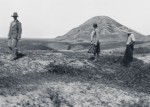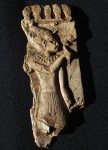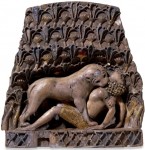In 1929, fresh off an acrimonious divorce from her first husband Archibald, Agatha Christie visited the excavations at the ancient city of Ur, in what is today Iraq. Renowned British archaeologist Leonard Woolley led the joint expedition of the British Museum and the University Museum of Pennsylvania over the twelve years (1922–34) of the excavation, and he was not welcoming of tourists. Agatha Christie was an exception, however, mainly because Leonard’s wife Katharine was a huge fan of the writer.
Katharine Woolley invited her back for a follow-up visit in 1930, and sent apprentice archaeologist Max Mallowan to show her the sights, wink, wink, nudge, nudge. When Christie had to return home urgently because her daughter was ill, Mallowan accompanied her back to England. A few months later, Max returned again to England and this time he asked Agatha to marry him. She accepted.
 Mallowan decided to make that season of excavations at Ur his last, looking for work on archaeological sites that would let Agatha work alongside him. In 1931 they would work their first dig together at Nineveh. Agatha didn’t just sit on the patio fanning herself. She got her hands dirty working as a junior assistant, cleaning, repairing and cataloging artifacts. For decades after that (with a break for World War II) they would work archaeological digs all over Iraq and Syria, making major discoveries.
Mallowan decided to make that season of excavations at Ur his last, looking for work on archaeological sites that would let Agatha work alongside him. In 1931 they would work their first dig together at Nineveh. Agatha didn’t just sit on the patio fanning herself. She got her hands dirty working as a junior assistant, cleaning, repairing and cataloging artifacts. For decades after that (with a break for World War II) they would work archaeological digs all over Iraq and Syria, making major discoveries.
In 1949, Mallowan reopened excavations on the site of Nimrud, the city that had once been the capital of the Assyrian Emprire at its peak under King Ashurnasirpal II (883-859 B.C.). Royal palaces had been found on the site in the mid-19th century — archaeologist Henry Layard had famously shipped giant winged stone bulls and lions from Nimrud to the British Museum — but it had been abandoned by archaeologists from 1879 onwards. Mallowan thought there was more to be found, and he was right.
 He found thousands of ivory carvings in storage rooms and at the bottom of wells, many of them with scorch marks from the destruction of the palace by the Medes and Persians in the late seventh century BC.
He found thousands of ivory carvings in storage rooms and at the bottom of wells, many of them with scorch marks from the destruction of the palace by the Medes and Persians in the late seventh century BC.
Agatha appears to have played an important role in the conservation of these ivory carvings. Mallowan said in his memoirs that it was Agatha’s idea to keep the pieces that had been found in the sludge at the bottom of the well moist and only gradually introduce them to the dry desert air. She described her cleaning process in her An Autobiography published in 1977, the year after her death:
I had my part in cleaning many of them. I had my own favourite tools … an orange stick, possibly a very fine knitting needle – one season a dentist’s tool which he lent, or rather gave me, and a jar of cosmetic face cream, which I found more useful than anything else for gently coaxing the dirt out of the crevices without harming the friable ivory. In fact there was such a run on my face cream that there was nothing left for my poor old face after a couple of weeks!
 Obviously curators today don’t recommend the face cream and knitting needle approach to cleaning ancient ivory, but it doesn’t seem to have harmed the very delicate pieces which still show signs of the gold foil and precious stones that used to festoon them before they were stripped and tossed in storage at some point in their ancient past. They are considered the finest collection of decorative ivories ever discovered in the Middle East.
Obviously curators today don’t recommend the face cream and knitting needle approach to cleaning ancient ivory, but it doesn’t seem to have harmed the very delicate pieces which still show signs of the gold foil and precious stones that used to festoon them before they were stripped and tossed in storage at some point in their ancient past. They are considered the finest collection of decorative ivories ever discovered in the Middle East.
Most of the ivories returned to storage after their excavation. The finds were divided between Iraq and Britain, with the British share of the spoils ending up in storage first at the British School of Archaeology in Iraq (now the British Institute for the Study of Iraq), then at the British Museum. They were never put on display.
Now thanks to a fundraising drive that raised £750,000 ($1.2 million) in six months, plus grants from the National Heritage Memorial Fund and the Art Fund, the British Museum has paid £1.2 million ($2 million) for 6,000 of the Nimrud ivory pieces. One thousand is numbered individual pieces; 5,000 are fragments of larger pieces.
The best of the collection will go on display in the British Museum’s Middle East section starting next week.
It is necessary to publish more details about Agatha’s archaeological contribution to excavations in Ur, Nineveh and Syria.